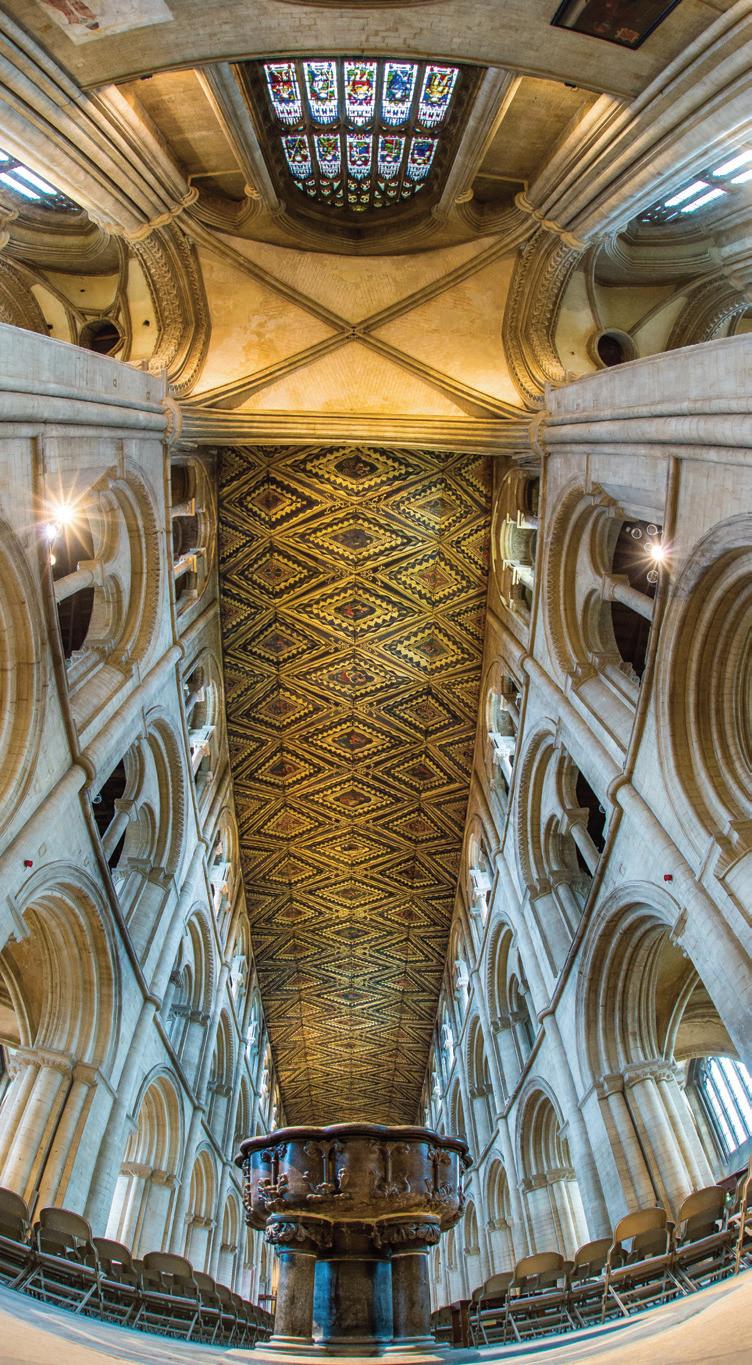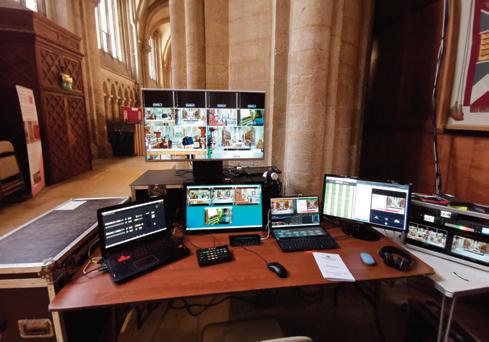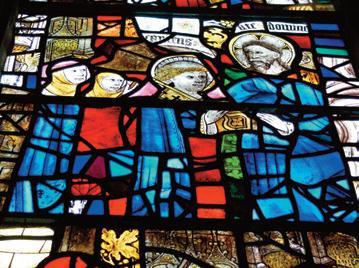
12 minute read
900 YEARS OF HISTORY
900 YEARS 900 YEARS of HISTORYof HISTORY
Peterborough’s magnificent Cathedral Church of St Peter, St Paul and St Andrew is over 900 years old and is looking forward to welcoming back visitors as restrictions are gradually lifted...
Advertisement
Words: Rob Davis.




Peterborough Abbey, which became a Cathedral in 1541, has been at the centre of national and international events for over 900 years...
IT’S THE MOTHER CHURCH OF RUTLAND as well as Northamptonshire and Peterborough: the Cathedral Church of St Peter, St Paul and St Andrew. For nearly a millennium, this place has been at the very heart of Peterborough. It has become an icon for the city, a landmark for the many businesses and organisations located here. Geographically it is right in the city centre, conveniently close to the shops, coffee shops and restaurants and only a short distance away from the rail and road links that connect it to London and A1 corridor to the north.
And as one would expect from nearly 1,000 years of progress, the site has seen some changes, from devastating Viking raids to a Reformation reprieve, followed by extensive Civil War damage and a period of 19th century renewal. Yet this ancient building very much has a foot in the 21st century. During lockdown, whilst the Cathedral was uncharacteristically quiet and opening hours were cut to a minimum or cancelled, there has been activity behind the scenes. Experienced stonemasons and scanning experts AH Scanning Ltd were hard at work with hi-tech equipment to create what they believe to be one of the most in-depth digital captures of an historic building ever carried out. Their work has covered the interior and exterior of the building, even abseiling down the West Front with a laser scanner when required. “We think that Peterborough Cathedral may well be the most digitally recorded historic building ever at this point, with 16 billion data points and over 30,000 images,” says Graham Sykes, Technical Director of Architectural & Heritage Scanning Ltd. “Similar work has been carried out at Notre Dame Cathedral and at Westminster Abbey but this is not quite so in-depth as we have used a wider range of scanners and methods to capture different levels of detail. We see the project as a unique case study or test piece to assess what can be achieved.”
The resulting images will provide safer and more cost-effective access to information for maintenance and repair purposes.

It will also become a rich and inspiring educational resource for schools and others learning about the Cathedral. Work is just beginning on the creation of digital tours of the building and the possibilities for generating 3D printed replica objects are being explored. Who knows, one day soon you may be able to buy a 3D printed Peterborough Cathedral chess set! Reducing the carbon footprint of the Cathedral also took a step forward in 2020 when, thanks to sponsorship from the Peterborough-based international coffee company Masteroast, nearly 300 low energy LEDs were installed to replace the existing 275 watt halogen bulbs. Once activity returns to the Cathedral visitors should notice significantly improved lighting levels and there is a keen expectation of reduced electricity bills. Worship, which has happened daily on site for centuries, has not been stopped by the pandemic but has certainly had to become more inventive. Congregations have been joining in with a variety of services online via Zoom, Facebook and YouTube. The Sunday Eucharist has been live streamed from the Cathedral during lockdown three and is led by a just handful of clergy and musicians to keep numbers to a minimum. A special prayer trail of lament and hope ‘Covid-19: All We Have Lost’ has been
900 YEARS OF HISTORY
Over the next couple of pages we’ll take a tour through 900 years of history at Peterborough Cathedral...
Roman Period: Evidence shows that there may have been a substantial building here, possibly a temple or monumental arch. 655AD: A monastery is founded on the current cathedral site. 870AD: It’s believed that the monastery was attacked and destroyed by Viking invaders. 966-970AD: The monastery is refounded by King Edgar and Bishop Aethelwold of Winchester as a Benedictine house. 1066: King Harold’s army stops at Peterborough en route from York to Hastings. 1070: The monastery is raided by an army of Danish mercenaries led by Hereward the Wake to stop its treasures falling into Norman hands. 1071: William I imposes the living of sixty knights onto Peterborough Abbey and its monastic estates. 1102: Flemish mercenaries attack the monastery and take most of the gold and silver. 1116: The Anglo-Saxon Chronicle reported that an unattended fire in a bakery spread into the monastery and the town causing a lot of damage. >>
adapted for online viewing, having originally been devised as a series of contemplative stops on a walk through the Cathedral. Holy Week and Easter, that great celebration of the Christian faith, was entirely online during 2020 but 2021 offers the possibility – it’s not yet confirmed as Pride goes to press – of being open for public worship in some form once again. For all the inventiveness and creativity of these times, the reality is that for a whole year almost all income generating events have been cancelled and visitor footfall, and therefore donations, have been drastically reduced. Whilst Covid-related grants and subsidies have been sought and gratefully received, it continues to be a constant challenge to meet the daily running costs of £4,200. So, with visiting restrictions due to be eased in April as Pride goes to press (and we caveat anything mentioned here as remaining subject to the rules), we think that one of the first places to enjoy a local, socially distanced day out ought to be Peterborough Cathedral. Even if you believe you’re familiar with the building and its history, you can always discover something new in a building with nearly a millennium of history.
Take a Highlights Tour When you visit the Cathedral – check the website for opening times – you can of course explore independently, but a tour with one of the knowledgeable and dedicated volunteers guides is recommended. They have an incredible passion for the building and a real enthusiasm for revealing some of its many secrets to visitors. The Highlights Tour is designed to ensure you don’t miss any of the Cathedral’s key features. It is offered on selected dates and takes around and hour to complete. The charge is just £5, which can be paid by card on arrival. If you want a tour on a specific date, it’s advisable to contact the Cathedral in advance so that spaces can be reserved.

View from the Tower If, on the other hand, you’d like to see the building from a whole new perspective, then take a Tower Tour.
These see visitors being taken up to the triforium level, above the Apse Chapel and transepts, then continuing up inside the central tower and outside onto the top of the tower for views of the city and beyond. The route comes down the stairs of the North West Tower where you can see into the Ringing Chamber and view the medieval windlass and fantastic roof gables.
Cathedral Keys project will secure future...
Peterborough Cathedral has launched its new fundraising project, Cathedral Keys, an opportunity for those who love and care for the building to play their part in its future. Cathedral Keys invites supporters – whether they be individuals, groups or businesses – to pledge a regular monthly amount over three years. Not only will donors be helping to maintain the magnificent building and Precincts as an asset for the city, they will also enable the Cathedral to unlock plans to develop its work as a place of worship, learning, hospitality and service in future years. All those who sign up to Cathedral Keys, whether as a Key Keeper (for less than £2 a week), a Guardian or a Custodian, will receive a bespoke pin badge and, once Covid restrictions are lifted, invitations to special events and briefings at the Cathedral so that they can keep informed about current and future plans.
n To find out about Cathedral Keys visit www.peterborough- cathedral.org.uk/keys or call Dawn Caplin on 07849 946937. It really is a fascinating tour and lasts about two hours, costing £15 per person. Check the website for dates and times.
Zoom Talks If you don’t manage to make it to the Cathedral this month, you can still enjoy its history thanks to divine – or rather online –intervention.
On Thursday 22nd April at 7.30pm and Saturday 24th April at 4pm, tour guide Mark Short will tell the story of the Cathedral’s iconic 13th century wooden nave ceiling. Completed around the year 1250, it is the only surviving wooden ceiling of its age in the whole of the UK. Meanwhile on Thursday 6th May, Revd Dr Sam Wells, Vicar of St Martin’s in the Fields London, will give the Peter Peckard Lecture. His subject will be ‘Act Justly: Church, Kingdom and Civil Society.’ The Lecture is a tribute to the contemporary social concerns of Peter Peckard, the 18th century Abolitionist and former Dean of Peterborough. Each Zoom event will require a ticket, with each household able to join the talk for £5 or £7.
Music in Lockdown Music has always been at the centre of worship, and an expression of joy in the building, so during lockdown, it was essential that the Cathedral’s Director of Music Tansy Castledine ensured that the life of a Cathedral Chorister could continue. >>

>> 1118: Building started on the replacement monastic church - the building we see today. 1143: King Stephen visits the monastery c.1150: Abbot Martin de Bec creates a new market area to raise funds for the building of the monastic church. The monks create new commercial streets which is effectively the same street plan that exists in the city centre today. 1154: King Henry II visits along with Chancellor Thomas Becket. 1174-77: This is when the Becket Chapel was constructed 1216: King John stays at the monastery. 1238: The new monastic church is consecrated. The building today is of the original style & pattern. 1268: Upon King Henry III’s visit, he grants the rights for a town fair. 1272 – 1286: The Lady Chapel is added to the monastery. This was pulled down during the Civil War. 1302: King Edward I visits. 1349: The Black Death hits Peterborough resulting in 32 of the 64 monks at the monastery perishing. 1536: Katharine of Aragon, first wife and queen of Henry VIII, is buried in the monastic church. See later in this edition for more on her legacy in Peterborough. >>


>> “We are immensely fortunate to have 50 highly committed and dedicated choristers here at Peterborough Cathedral,” says Tansy. “I feel truly humbled at the amount of energy, courage, conviction, enthusiasm, independence, and aspiration invested by each chorister into continuing with choir and their singing, in the absence of being able to meet and rehearse in person.” “Throughout lockdown, the children have undertaken a mixture of different styles of sessions, meeting ‘virtually’ over video conference, to enable them to continue developing their vocal and technical skills, as well as maintaining their enthusiasm. They have all undertaken audio or video recordings it’s been wonderful to see the resilience that they all have shown!” Recently the Cathedral announced that their Organ Scholar, Imogen Morgan, has been awarded the Fellowship Diploma from the Royal College of Organists. “This is a really superb achievement,” said Tansy. “Everyone here at the Cathedral is delighted for Imogen and so proud! She’s a talented musician and her future looks very bright indeed.” You can hear Imogen perform a programme of joyful organ music for Easter Sunday via Zoom from 6pm on Sunday 4th April, free of charge, although donations to the Cathedral are welcome.
Cathedral Keys As seen on our previous spread, the Cathedral is inviting people who love the place to become ‘Cathedral Key Keepers.’ By seeking regular donations, with options starting from as little as £2 a week, the scheme aims to raise £160,000 a year to help with costs and demonstrate the self-help needed to attract awards from grant funders. Those who join Cathedral Keys are helping to unlock the long-term financial stability of the Cathedral. It’s an essential programme of fundraising to ensure that this place of worship, learning, hospitality and service can continue to be here for generations to come.


n Visit Peterborough Cathedral’s website for up-to-date information on opening times and events. Visit www.peterborough-cathedral.org.uk or see 01733 355315, Peterborough PE1 1XS.

>> 1541: To increase his control over the church in the area Henry VIII created a new bishop (the former abbot John Chambers) and Peterborough Abbey church became a Cathedral by letters patent. 1587: Mary Queen of Scots is buried at Peterborough Cathedral in August, five months after her execution at Fotheringhay Castle. 1643: Civil War results in a lot of damage to the Cathedral. 1822-20: It’s only now that the Civil War damage is gradually repaired. 1870: A Girl’s School is established in Laurel Court, later attended by Edith Cavell as a teenage pupil teacher. 1941-1944: The vigilance of ARP Wardens protects the Cathedral from major damage during air raids on the city. 1975: Queen Elizabeth II gives Maundy Money at the Cathedral. 2001: A fire breaks out in the South Transept which requires a major restoration. 2018: The Cathedral’s 900th anniversary celebrations culminated in Tim Peake’s Soyuz capsule being exhibited at the Cathedral. The capsule was accompanied by the Space Descent virtual reality experience. The Cathedral follows its traditional pattern of worship as well as providing a great service to the local community including many events, education and performances. n













